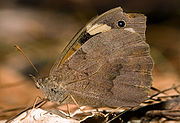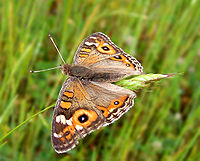
Meadow Argus
Encyclopedia
The Meadow Argus is a butterfly
in the family Nymphalidae
, commonly found in Australia
. It is also known as Albin's Hampstead Eye in the United Kingdom
, where it has occurred only as an accidental import.
as well as white and orange marks that appear on the edge of the wings. The eyespots are a defense mechanism that are not only used to frighten predators away, but also to confuse the predators into thinking that the eyespots are the target, allowing the butterfly to escape with only a small part of the wing being lost. The underside of the wings are mainly unmarked, except the lower part of the fore wing has similar markings as the upper side. The wingspan measures 4 centimetres (1.6 in) in males and 4.3 centimetres (1.7) in females.
As the butterfly rests, it can sit in four different positions depending on the current situation. These positions include:
, Kangaroo Island
, Lord Howe Island
, New Zealand
, Norfolk Island
, Fiji
, Papa New Guinea, Indonesia
, Samoa
and Cook Islands
. They reside in urban areas, forests, woodlands, and grasslands, though they are uncommon during the winter months. Every year during October or November, the butterflies migrate from southern Australia to warmer areas in the north.


e are black with short thin spines. Meadow Argus caterpillars feed on various garden plants, both native and introduced. This includes Plantago
, Scrophulariaceae
, Convolvulaceae
, Compositae, Verbenaceae
, Porulacaceae, and Gentianaceae
. This stage lasts from 4 to 5 weeks.
Butterfly
A butterfly is a mainly day-flying insect of the order Lepidoptera, which includes the butterflies and moths. Like other holometabolous insects, the butterfly's life cycle consists of four parts: egg, larva, pupa and adult. Most species are diurnal. Butterflies have large, often brightly coloured...
in the family Nymphalidae
Nymphalidae
The Nymphalidae is a family of about 5,000 species of butterflies which are distributed throughout most of the world. These are usually medium sized to large butterflies. Most species have a reduced pair of forelegs and many hold their colourful wings flat when resting. They are also called...
, commonly found in Australia
Australia
Australia , officially the Commonwealth of Australia, is a country in the Southern Hemisphere comprising the mainland of the Australian continent, the island of Tasmania, and numerous smaller islands in the Indian and Pacific Oceans. It is the world's sixth-largest country by total area...
. It is also known as Albin's Hampstead Eye in the United Kingdom
United Kingdom
The United Kingdom of Great Britain and Northern IrelandIn the United Kingdom and Dependencies, other languages have been officially recognised as legitimate autochthonous languages under the European Charter for Regional or Minority Languages...
, where it has occurred only as an accidental import.
Description
The Meadow Argus has two brownish wings, each covered with two distinctive black and blue eyespotsEyespot (mimicry)
An eyespot is an eye-like marking. They are found on butterflies, reptiles, birds and fish. In members of the Felidae family , the white circular markings on the backs of the ears are termed ocelli, and they are functionally similar to eyespots in other animals.Eyespots may be a form of...
as well as white and orange marks that appear on the edge of the wings. The eyespots are a defense mechanism that are not only used to frighten predators away, but also to confuse the predators into thinking that the eyespots are the target, allowing the butterfly to escape with only a small part of the wing being lost. The underside of the wings are mainly unmarked, except the lower part of the fore wing has similar markings as the upper side. The wingspan measures 4 centimetres (1.6 in) in males and 4.3 centimetres (1.7) in females.
As the butterfly rests, it can sit in four different positions depending on the current situation. These positions include:
- If the sun is shining, the butterfly will open and relax its wings
- If danger approaches while in the sunlight the butterfly will open its wings further revealing eyespots on its hindwings
- If the sun is not shining the butterfly will close its wings
- If danger approaches while there is no sunlight the butterfly will raise its frontwings revealing hidden eyespots
Distribution and habitat
The Meadow Argus can be found mainly on the Australian mainland, as well as in TasmaniaTasmania
Tasmania is an Australian island and state. It is south of the continent, separated by Bass Strait. The state includes the island of Tasmania—the 26th largest island in the world—and the surrounding islands. The state has a population of 507,626 , of whom almost half reside in the greater Hobart...
, Kangaroo Island
Kangaroo Island
Kangaroo Island is Australia's third-largest island after Tasmania and Melville Island. It is southwest of Adelaide at the entrance of Gulf St Vincent. Its closest point to the mainland is off Cape Jervis, on the tip of the Fleurieu Peninsula in the state of South Australia. The island is long...
, Lord Howe Island
Lord Howe Island
Lord Howe Island is an irregularly crescent-shaped volcanic remnant in the Tasman Sea between Australia and New Zealand, directly east of mainland Port Macquarie, and about from Norfolk Island. The island is about 11 km long and between 2.8 km and 0.6 km wide with an area of...
, New Zealand
New Zealand
New Zealand is an island country in the south-western Pacific Ocean comprising two main landmasses and numerous smaller islands. The country is situated some east of Australia across the Tasman Sea, and roughly south of the Pacific island nations of New Caledonia, Fiji, and Tonga...
, Norfolk Island
Norfolk Island
Norfolk Island is a small island in the Pacific Ocean located between Australia, New Zealand and New Caledonia. The island is part of the Commonwealth of Australia, but it enjoys a large degree of self-governance...
, Fiji
Fiji
Fiji , officially the Republic of Fiji , is an island nation in Melanesia in the South Pacific Ocean about northeast of New Zealand's North Island...
, Papa New Guinea, Indonesia
Indonesia
Indonesia , officially the Republic of Indonesia , is a country in Southeast Asia and Oceania. Indonesia is an archipelago comprising approximately 13,000 islands. It has 33 provinces with over 238 million people, and is the world's fourth most populous country. Indonesia is a republic, with an...
, Samoa
Samoa
Samoa , officially the Independent State of Samoa, formerly known as Western Samoa is a country encompassing the western part of the Samoan Islands in the South Pacific Ocean. It became independent from New Zealand in 1962. The two main islands of Samoa are Upolu and one of the biggest islands in...
and Cook Islands
Cook Islands
The Cook Islands is a self-governing parliamentary democracy in the South Pacific Ocean in free association with New Zealand...
. They reside in urban areas, forests, woodlands, and grasslands, though they are uncommon during the winter months. Every year during October or November, the butterflies migrate from southern Australia to warmer areas in the north.


Eggs
Meadow Argus eggs are laid on a leaf of the food plant, shaped with sturdy vertical and horizontal ribs. The eggs usually hatch within 7 to 10 days.Larvae
Meadow Argus larvaLarva
A larva is a distinct juvenile form many animals undergo before metamorphosis into adults. Animals with indirect development such as insects, amphibians, or cnidarians typically have a larval phase of their life cycle...
e are black with short thin spines. Meadow Argus caterpillars feed on various garden plants, both native and introduced. This includes Plantago
Plantago
Plantago is a genus of about 200 species of small, inconspicuous plants commonly called plantains. They share this name with the very dissimilar plantain, a kind of banana. Most are herbaceous plants, though a few are subshrubs growing to 60 cm tall. The leaves are sessile, but have a narrow...
, Scrophulariaceae
Scrophulariaceae
Scrophulariaceae, the figwort family, are a family of flowering plants. The plants are annual or perennial herbs with flowers with bilateral or rarely radial symmetry. Members of the Scrophulariaceae have a cosmopolitan distribution, with the majority found in temperate areas, including...
, Convolvulaceae
Convolvulaceae
Convolvulaceae, known commonly as the bindweed or morning glory family, are a group of about 60 genera and more than 1,650 species of mostly herbaceous vines, but also trees, shrubs and herbs.- Description :...
, Compositae, Verbenaceae
Verbenaceae
Verbenaceae, commonly known as the verbena family or vervain family, is a family of mainly tropical flowering plants. It contains trees, shrubs and herbs notable for heads, spikes, or clusters of small flowers, many of which have an aromatic smell.Recent phylogenetic studies have shown that...
, Porulacaceae, and Gentianaceae
Gentianaceae
Gentianaceae are a family of flowering plants of 87 genera and over 1500 species. Flowers are actinomorphic and bisexual with fused sepals and petals. The stamens are attached to the inside of the petals and alternate with the corolla lobes. There is a glandular disk at the base of the gynoecium,...
. This stage lasts from 4 to 5 weeks.

